Heath Aster – A Tough Fall Wildflower for Pollinators
This post may contain affiliate links. Read my full disclosure here.
Heath aster is a tough, late-season bloomer that lights up prairies, roadsides, and gardens with clouds of tiny white flowers. If you’ve ever walked through a field in September and seen what looked like a drift of stars scattered across the plants, you may have met heath aster.
This native perennial thrives in poor soils where other plants struggle, making it a great choice for low-maintenance pollinator gardens. It’s also an important nectar source when many other flowers have finished blooming.
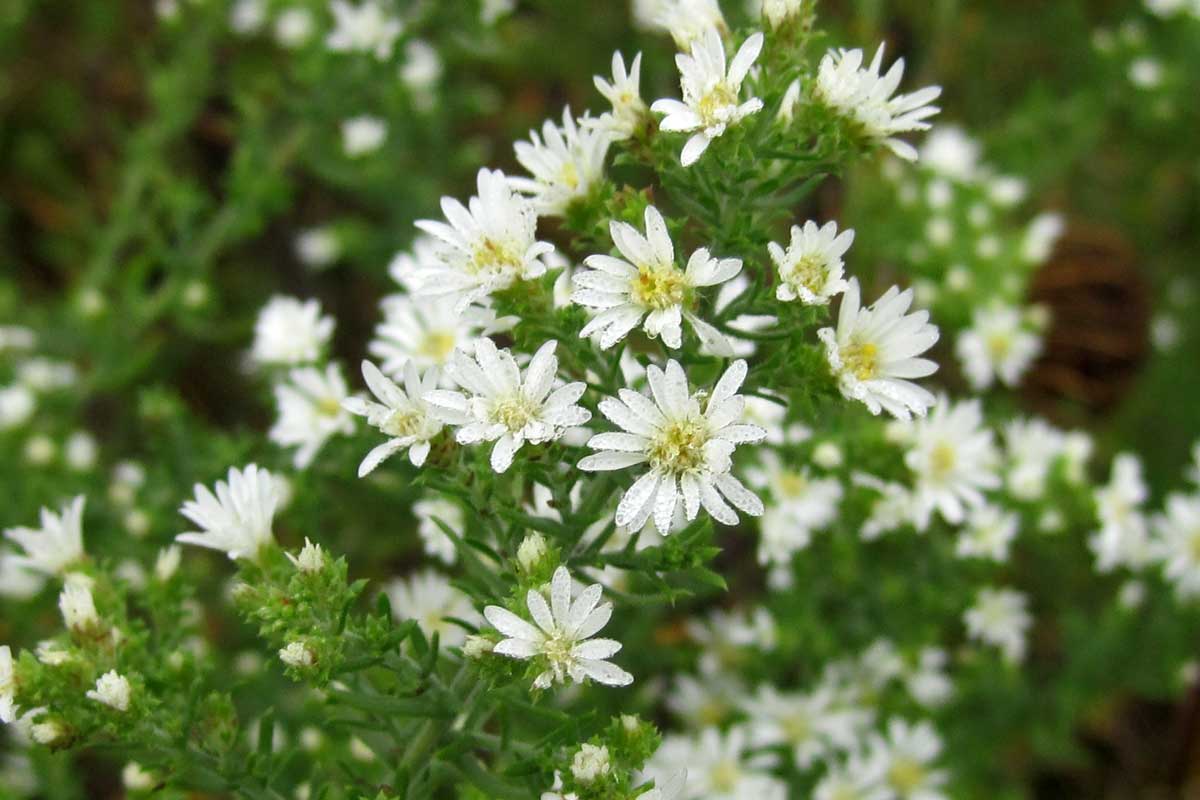
Table of Contents
Where to Find Heath Aster (Symphyotrichum ericoides)
Note: Symphyotrichum ericoides was formerly known as Aster ericoides.
Heath aster is perennial, native to the North America. It occurs from Maine to southern Saskatchewan, south to Virginia, Texas, northern Mexico and southeast Arizona. (see map). It’s a prairie plant, preferring full sun and dry conditions.
The image below is from the semi-wild areas of our homestead, taken in September 2012. You can see the native wildflowers surrounding the path.
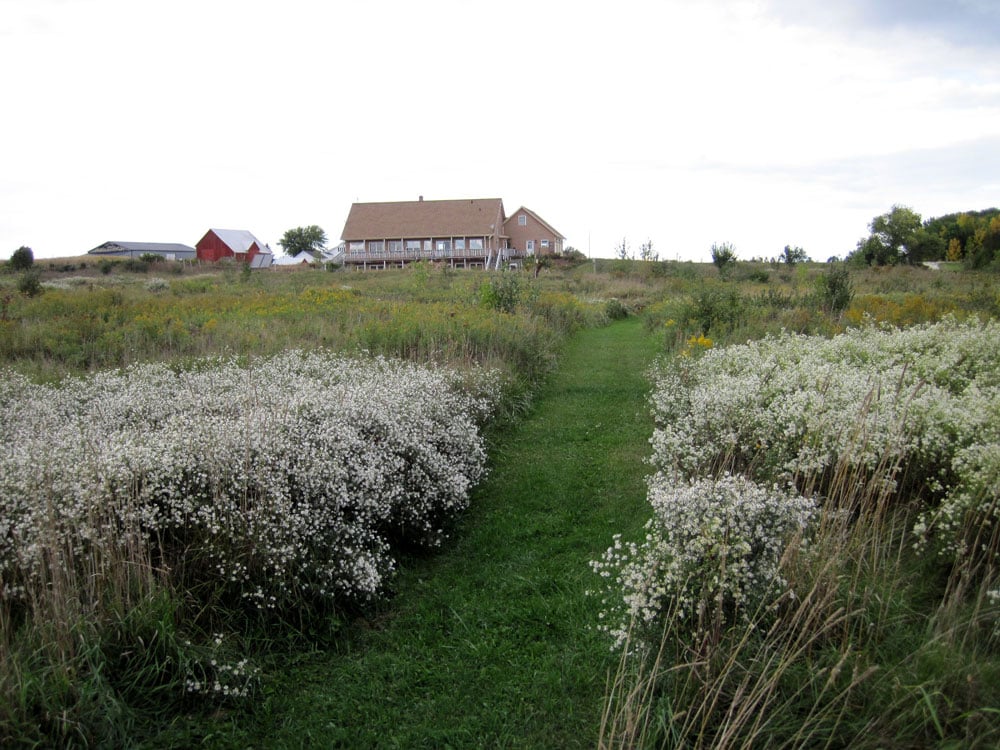
How to Identify Heath Aster
Height: 1 to 3 feet tall, sometimes taller in rich soil.
Leaves: Narrow, stiff, and bristle-like — often compared to heath or heather, which inspired the name. Lower leaves are longer; upper leaves are small and scale-like. They attach in an alternating pattern up the stem.
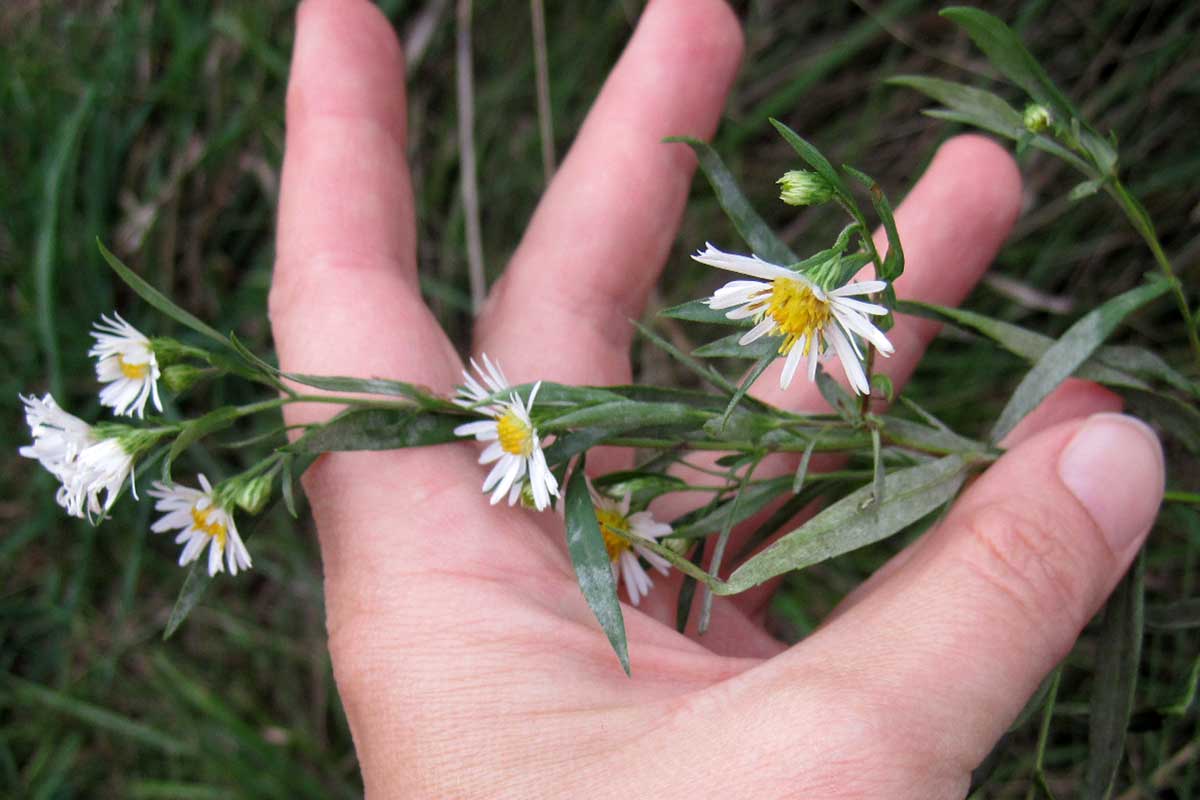
Stems: Usually stiff, often branching, forming rounded clumps. Lower leaves die off as the plant matures, and the stems turn from green to brown. The plant is just a little bit fuzzy, not outright hairy.
Flowers: Tiny daisy-like blooms (about ½ inch across) with white to pale lavender rays and yellow centers that turn reddish with age. Blooms appear in dense clusters from late summer into fall.
A single plant can produce over 100 flowers, which are clustered near the top of the plant. They have a compound flower, like the ox-eye daisy, made up of tiny florets, and measuring under 1/2 inch across. (You can use my hand for a rough scale). There are 8-20 rays (petals) surrounding a center disk that turns from yellow to brown as the flower matures.
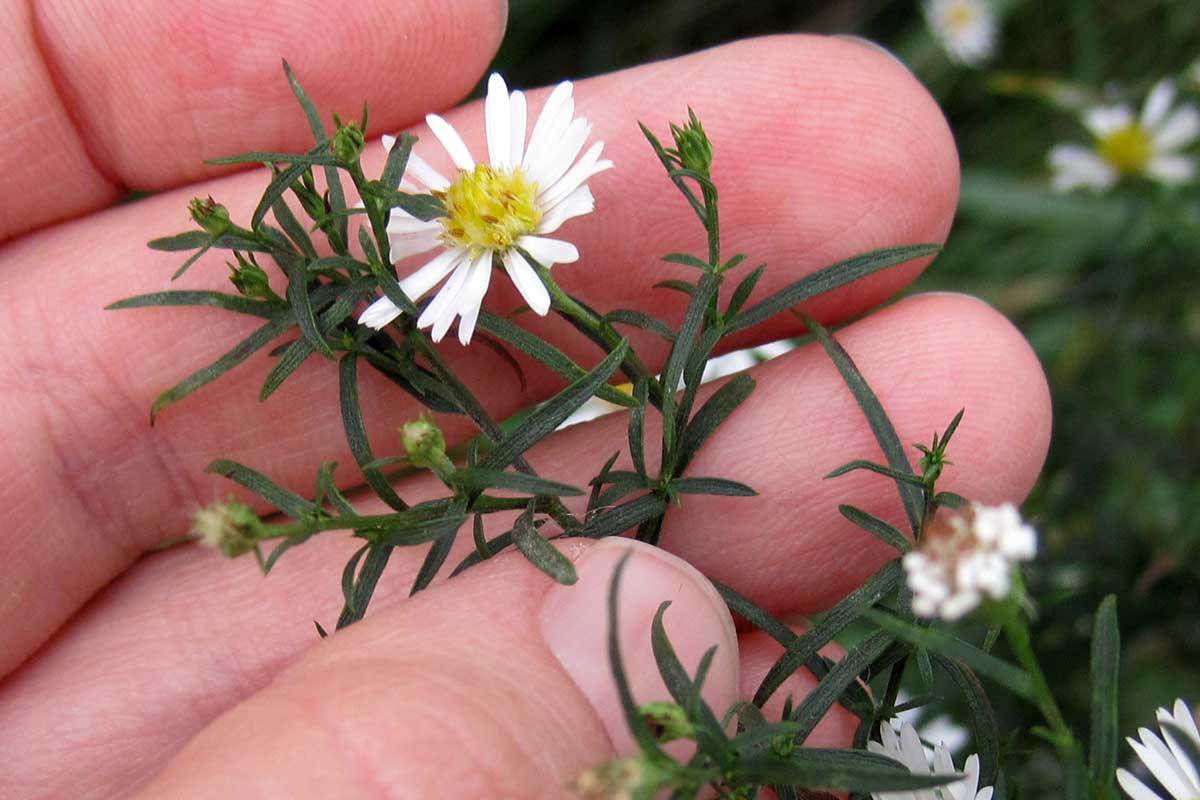
Bloom time: Typically August through October, sometimes into November depending on your location. They provide nectar when many other plants have already finished blooming. Our meadows are humming.
Propagation: The roots are rhizomes, so they tend to spread in clumps, but the seeds are also carried on the wind. Once the flowers fade, the seed heads get tufts of white hairs, which allow them to be spread on the wind.
Look-alikes: Several other native asters bloom in late summer. Heath aster is distinguished by its small, crowded flowers and fine, bristle-like foliage.
Here’s a nice area in our yard where you can see health aster, New England aster , milkweed and goldenrod.
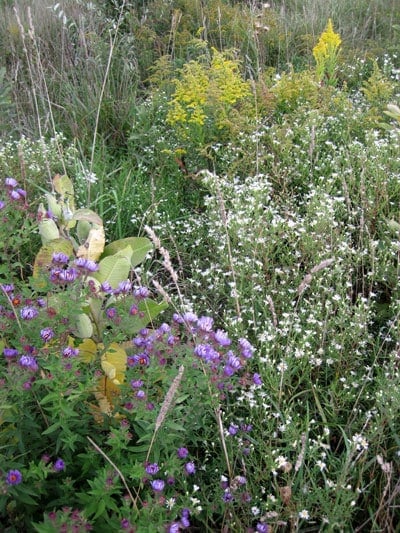
Growing Conditions and Care
Heath aster is one of the hardiest asters, thriving in places where many ornamentals fail.
Would you like to save this?
- Soil: Adapts to poor, sandy, or rocky soils. Prefers well-drained sites.
- Sunlight: Full sun is best, though it tolerates light shade.
- Water: Very drought-tolerant once established.
- Maintenance:
- Can self-seed freely and spread by rhizomes. Thin clumps if they become too aggressive.
- Deadhead or cut back after flowering to manage spread.
- Divide every few years to keep plants vigorous.
This resilience makes it ideal for naturalized plantings and prairie gardens.
Is heath aster invasive?
It’s not technically invasive, since it’s a native plant, but it can spread aggressively in rich soils. Thin or cut back if needed.
Wildlife and Pollinator Value
- Bees: Heath aster is a valuable late-season nectar and pollen source for native bees and honeybees.
- Butterflies & moths: Attracts monarchs and other fall-migrating butterflies, as well as moth caterpillars that use it as a host plant.
- Birds: Goldfinches and other seed-eaters enjoy the dried seed heads in winter.
- Mammals: White-tailed deer and rabbits may eat the young growth, but largely ignore mature plants.
When most flowers are fading, heath aster keeps pollinators fed until frost.
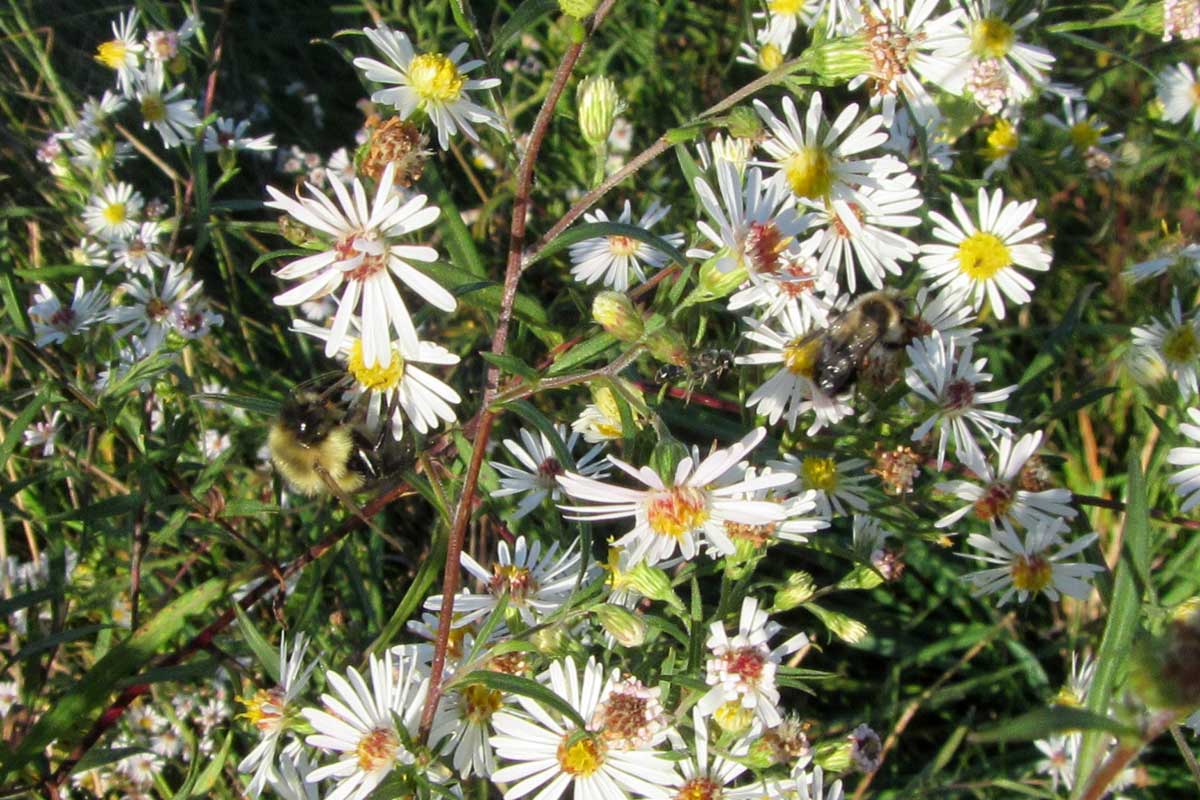
Medicinal Uses
Native Americans used various aster species for medicine, including teas for coughs and poultices for skin issues. The Navajo used this aster to make teas and lotions used for curing snake bites. Other groups used these asters in steam lodges, laying branches on the hot rocks to create herbal steam. White heath aster was also used medicinally to revive unconscious patients.
No dosage recommendations were readily available. Always exercise caution when using any wild plants. Make sure you have positively identified the plant and are not allergic.
Other Names
Other names for heath aster include:
- White Aster
- Awl-aster
- Subulate-bracted Aster
- Hairy Aster
- Soft Aster
- Squarrose White Aster
- White Prairie Aster
- Heath White Aster
- Many-flowered Aster
- Tufted White Prairie Aster.
More Herbal Resources
This article is part of the Weekly Weeder series, where we learn how to identify, use, and manage wild plants.
You may also enjoy other related articles, including:
- My Favorite Foraging & Wildcrafting Books
- Harvesting and Using Dandelion Roots for Food & Medicine
- How to Make Elderberry Syrup with Fresh or Dried Berries
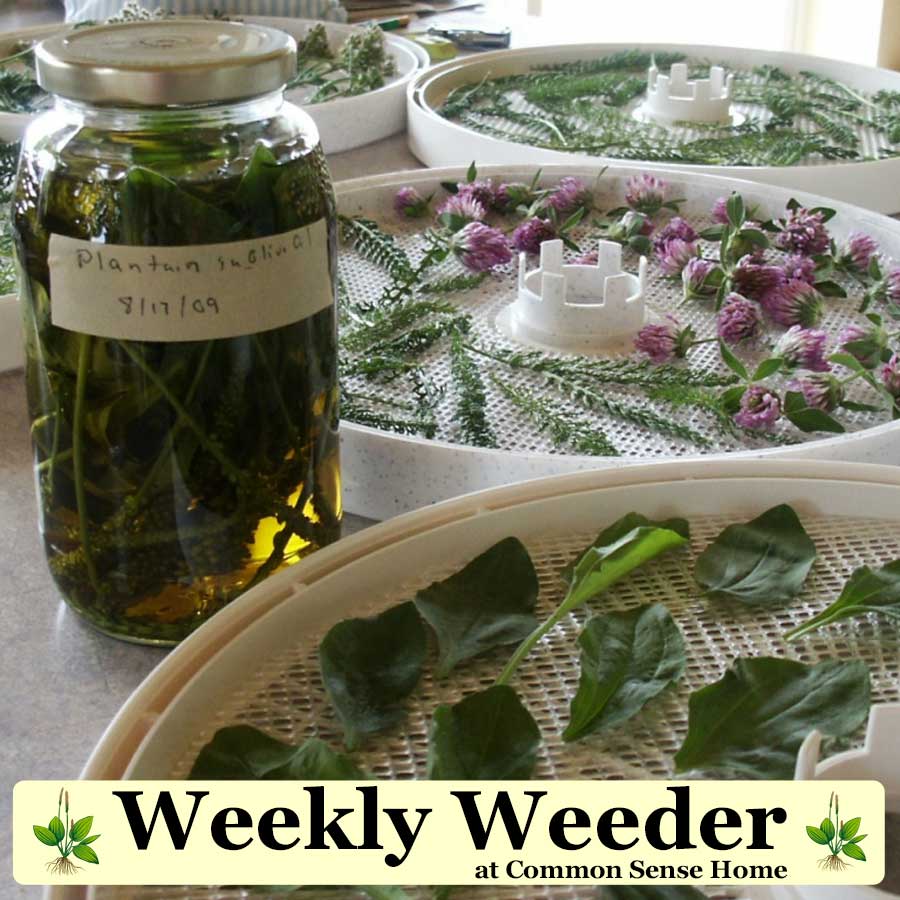

This article is written by Laurie Neverman. Laurie was raised on a small dairy farm in northwest Wisconsin, where she gathered wildflowers from the woods and pastures. She and her family now live in northeast Wisconsin, where they combine intentional plantings and semi-wild areas. Every season is a new opportunity to learn more about working with wild plants.
Originally published in 2012, last updated in 2025.

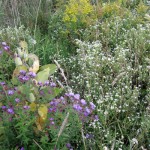
I noticed this plant in my garden bed in the Spring. I decided to let it grow. It is now October and the flowers are beautiful along with the bees.
Ours are still chugging along, too, though we’ve had light frost at this point.
I have been looking for a good close-up photo of White Heath Aster to add to a fact sheet that I am creating on this plant for our native seed and native plant giveaways in Colorado. May I use one of your excellent photos? Thank you for considering!
Yes, you may use photos with a credit to the source location.
Are the leaves and stems prickly? I was thinking of this for a ground cover in a small contained portion of the lawn to replace grass but don’t want something that will be prickly on my dog’s paws.
It’s not prickly, but the plants are pretty tall, around 1-3 feet, so it wouldn’t make a good groundcover. You can see in the one photo where we’ve mowed a walking path through the health aster patch.
Can you dry to use in teas??
Yes. The flowers become fluffy as they dry, but are still usable.
Are there any tea blends you suggest using with white heath aster?
I’m not aware of any commercial tea blends that use this plant.
Glad I found this site. Is it worth putting heath asters in my garden?
If you enjoy them, there’s no harm in doing so.
Can I add heath aster to bundles of sage for smudging?
I haven’t seen this suggested, but I don’t see a problem with it, given its historical uses.
Why does my dog like to eat my asters?
Dogs eat plants for a variety of reasons. Sometimes, they just want some roughage (they are omnivores). There may also be a missing nutrient in the dog’s diet. Other times dogs eat plants (usually grass) to stimulate vomiting. Animals sometimes self-medicate,too, seeking out specific plants/herbs/dirt for different conditions.
My dogs ha e been eating the tender new leaves on the purple tall asters for over 30 yrs they keep them paracite free let them forage on own for they no how to micro dose self.
Ghost Dancer
Red Road Creations
Barring a dog with an eating disorder (which unfortunately does happen), I agree that most animals will safely self-medicate. We’ve seen it with our cats and chickens, too, and bees will do it as well.
Just what I was searching for, appreciate it for posting.
I have a question, this looks like flea bane, could you clarify this for me. I think I see a difference but it would be cool for you to describe any difference. Thanks much.
Which kind of fleabane? There is Daisy Fleabane, which I think looks most similar, and Annual Fleabane. (There probably other fleabanes, too – this ID stuff can be tricky!)
Daisy fleabane has a tap root instead of rhizomes, and more white ray flowers (petals). It also has a scent. You can see photos and get more info at Illinois Wildflowers – http://www.illinoiswildflowers.info/prairie/plantx/ds_fleabanex.htm
Annual fleabane has hairs on the stem, and tends to be a bit taller. It, too, has more white ray flowers (petals) and may have a scent. The leaves appear larger towards the top of the plant, not delicate like the Heath Aster.
http://www.illinoiswildflowers.info/weeds/plants/an_fleabane.htm